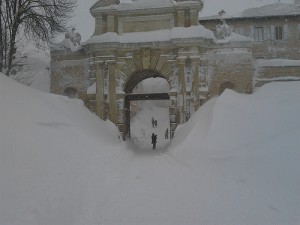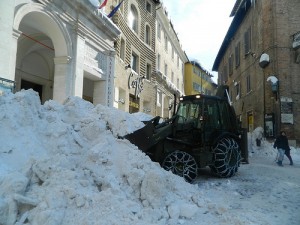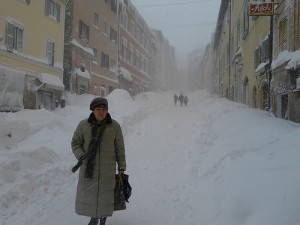 URBINO – When it started to snow, on Tuesday January 31st, people were dining in their homes. It was fun, at the beginning, and they were excited as they saw the first snowflake falling.
URBINO – When it started to snow, on Tuesday January 31st, people were dining in their homes. It was fun, at the beginning, and they were excited as they saw the first snowflake falling.
For a town set in the middle of the hills at a height of 1.640 feet, at the back of the Apennine mountains, the weather had been unusual until then: no rain the whole autumn and just one snowfall before Christmas. They couldn’t imagine the worst snowstorm they’d ever seen had just begun, with about 129 inches falling in ten days.
It didn’t stop until the next Tuesday. The first thing to fail was the electricity, as the cables gave way under the weight of the first snow. Suddenly, the whole city was plunged in darkness and for many houses in the countryside the blackout lasted for a week.
The water situation was no better: lots of pipes froze and some areas were unreachable for the water company. So Federica, a woman in her mid-forties, started drinking snow. When on February 7th they reached her house, isolated on the Cesane Hills since the beginning of the snowfall, she showed how her family and she had been drinking, cooking and washing themselves with snow from their yard.
 After the first week-end, the municipality realized that the city was unprepared to face the snowfall and its consequences. Teams of volunteer shovellers, mostly students, started to go house by house to help old people or just to shovel some parts of the streets.
After the first week-end, the municipality realized that the city was unprepared to face the snowfall and its consequences. Teams of volunteer shovellers, mostly students, started to go house by house to help old people or just to shovel some parts of the streets.
Just a couple of means of transport were able to clear the city, so the mayor called in the army. At the beginning, eight soldiers from nearby Pesaro: then as many as 49.
The old city of Urbino, surrounded by walls and with dozens of narrow back alleys, was completely submerged and the army were the only ones to have proper means to clear the streets and let the people reach the shops. As for the supermarkets, by the third day they were already empty. The trucks just weren’t able to reach the city, considering the fact that the whole center of Italy was facing a huge snowstorm.
At that time, all the media were concentrated on the pitiful 12 inches of snow in Rome, the most unprepared city ever. As soon as the controversies over the capital stopped, the media started to notice the tragedy that was going on in two regions: Abruzzo and Marche.
In Urbino, the province that had been declared the worst hit one, it was chaos. The hospital was full and the snow had infiltrated three of the five operating rooms. Two of the five ambulances were stuck in the snow in front of the hospital: the ones able to circulate got stuck plenty of times, because of the snow plough not being able to clear the road in front of them. Once, inside, there was a woman on dialysis.
 Then people started noticing something worrying on the roofs. The stalactites could sometimes reach over 78 inches long and the inhabitants started fearing them, as if they were blades on their heads. One day a stalactite fell on a man. Eventually, the mayor warned people not to go out if not absolutely necessary.
Then people started noticing something worrying on the roofs. The stalactites could sometimes reach over 78 inches long and the inhabitants started fearing them, as if they were blades on their heads. One day a stalactite fell on a man. Eventually, the mayor warned people not to go out if not absolutely necessary.
As the snofall stopped for 36 hours, the first roof started to collapse. It was a private apartment in the old city. It was followed by a Chinese restaurant, a cinema, two friaries, three churches, some farms and factories and dozens of private roofs around the city. Then the blizzard came.
On the night of February 11th, the snow had reached 80 inches. At that time, in an isolated house in San Marino di Urbino, a little hamlet on the hills, Emilia was about to give birth to her first baby. She had been trapped in her house for 10 days, unable to reach the main road. The rescuers had been trying to get to her since the morning and they managed just half an hour before Nica was born.
A few days before, Roberto was able to clear the road and take her wife to the hospital just in time for Emanuele’s birth: the municipality, he claimed, had abandoned them, with no rescuer to take her out of the house in Montesoffio, 3 miles away from the city center. On the night of February 11th, Sante and Maria Luisa were on their way to a relative’s house. They got stuck in the middle of the blizzard for hours, until the rescuers found them at 5 am. They were hugging each other in the snow to keep warm.
 By the end of the snowfall, the official stranded toll was 300 families. They were all living in hamlets more or less close to the city. Some of them were without water, others without heating. They were constantly in contact with the rescuers, but the roads were impassable even for the biggest snow plough the municipality had.
By the end of the snowfall, the official stranded toll was 300 families. They were all living in hamlets more or less close to the city. Some of them were without water, others without heating. They were constantly in contact with the rescuers, but the roads were impassable even for the biggest snow plough the municipality had.
The cars, however, were abandoned in the snow for weeks. Linda had just parked her car in a yard in front of a friend’s house on January 31st before having dinner. Three weeks later, she was able to shovel it out after four hours of work. Other cars weren’t as lucky as Linda’s.
They were left on the sides of the roads, becoming an indistinguishable part of a 120 inches-high blanket of snow. Some owners had put brooms, colored headscarves and mops to indicate them. As for the others, the snow ploughs just couldn’t see them and swept them with the snow. There are currently 54 claims for damages against the municipality.
At present, the province is counting the damages. As for the municipality, it has spent around 450 thousand euro for means of transport, fuel, staff, equipment, accommodation and meals. It calculates that it will spend 1 million euro more to repair the damage. Thirty million, furthermore, is the amount assessed for the companies’ damage. The Curia, for its part, estimates the reconstruction of its damaged buildings at around 60 million euro.
On February 20th, the Emergency State ended. But the snow had one, last surprise for the city: some hours before, the roof of the Operating Centre for the Emergency collapsed. Don’t count your chickens before they are hatched.







